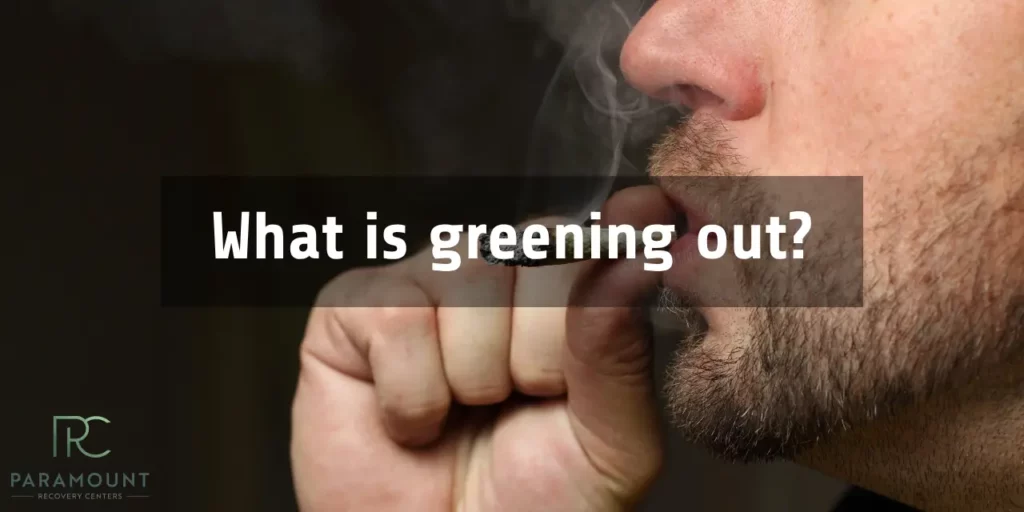Green out happens when someone consumes too much cannabis and experiences severe discomfort instead of the usual high. It often involves nausea, dizziness, and panic attacks. Knowing your limits and understanding the potency of the cannabis you consume can help prevent this unpleasant state. In this article, we’ll cover what greening out is, its symptoms, when it is most likely to occur, and how to manage or prevent it.
Key Takeaways
- Greening out is a severe state of discomfort from excessive cannabis consumption, characterized by physical and psychological symptoms, including nausea and anxiety.
- Novice users and those consuming high-potency cannabis products, especially edibles, are at greater risk of greening out, particularly on an empty stomach.
- Preventive measures such as starting with low doses, ensuring proper hydration, and being aware of individual limits can significantly reduce the likelihood of greening out.
What is Greening Out?

Experiencing a “green out” is the result of consuming too much cannabis, leading to intense discomfort instead of the desired euphoric sensation. Those who green out often feel extreme unease, fatigue, and are unable to appreciate the usual pleasurable effects associated with cannabis use.
The probability of greening out can be influenced by several factors related to an individual’s personal makeup. The likelihood increases depending on one’s body mass, tolerance threshold for cannabis consumption, and their past encounters with the substance. Crucially important is also the strength of the consumed product. Particularly potent varieties or those with high THC levels raise this risk considerably.
Being cognizant of both how strong your chosen cannabis products are as well as what they contain is vital in mitigating against an adverse experience such as greening out. With knowledge about these details comes a greater opportunity for ensuring that each interaction with cannabis remains enjoyable and free from undue distress.
Common Symptoms of Greening Out
Recognizing both the physical and psychological indicators of greening out is essential for its management and prevention. Physical manifestations often encompass feelings of nausea, vomiting, lightheadedness, and a heightened pulse rate. Not addressing these symptoms swiftly can lead to health complications.
The psychological impact should not be overlooked either. Symptoms such as intense anxiety, panic attacks, and disorientation are also common during a greening-out episode. These mental effects may worsen the accompanying physical discomforts in what becomes an escalating cycle of distress.
Experiencing an assortment of unwelcome signs like nausea, dizziness coupled with anxiety episodes or panic represent the harsh reality of greening out—a thoroughly aversive ordeal that extends beyond mere discomfort posing real risks to one’s well-being, especially when existing health issues are present or individuals find themselves unprepared for such potent reactions.
Awareness about individual tolerance levels along with understanding cannabis potency stands paramount to avoid experiencing these adverse outcomes related to greening out—prompt detection enables quick measures to alleviate negative consequences effectively.
When Are You Most Likely to Green Out?
The phenomenon of greening out is more frequently encountered by those who are new to using cannabis and haven’t yet gauged how it impacts them personally. Their inexperience and lack of knowledge about their own threshold for tolerance render them particularly prone to such incidents. Nevertheless, even individuals with extensive experience can succumb to greening out if certain factors come into play.
Consumption of edibles or concentrates that boast a high THC content markedly raises the likelihood of experiencing a green out. Given that these products pack greater amounts of THC—the active ingredient responsible for cannabis’s psychoactive effects—they yield stronger and more enduring reactions. Edibles pose an especially challenging issue due to their onset time. There’s often a delay before they take effect, which may lead some people to ingest higher quantities than necessary before feeling the initial impact.
Ingestion of cannabis while fasting might also amplify the chances of encountering a green out since food intake typically moderates the absorption rate of THC, leading its influence on users’ systems when consumed without eating first tends to be both harsher and quicker. Being conscious of these variables enhances one’s ability to make well-informed decisions regarding the consumption of atcannabis use.
Immediate Actions to Take If Someone is Greening Out

Persistent episodes of greening out may lead to grave and enduring consequences. Among these is the possibility of developing a substance use disorder known as marijuana use disorder, along with cannabinoid hyperemesis syndrome, indicative of sustained marijuana misuse. Such issues could evolve into long-standing health problems that necessitate expert intervention.
Extended exposure to cannabis has been linked to diminished cognitive functions including challenges in learning, memory retention disturbances, and compromised impulse control. These repercussions on mental health can significantly disrupt everyday activities and degrade life quality. The propensity for dependence coupled with a substance use disorder represents an additional grave concern for individuals who often experience greening out—underscoring both traditional risks associated with cannabis consumption as well as novel modern risks.
Although symptoms typically related to greening out subside within a day’s time frame, they can induce persistent side effects such as ongoing brain fog after the event passes. Prolonged impacts on cerebral function due to excessive ingestion of THC are apparent indications showing that undesirable outcomes from usage extend beyond the cerebral function. Than mere short-lived unease caused by high doses.
Preventing Greening Out
To avoid the possibility of greening out, it is wise to engage in cautious cannabis consumption. Starting with modest amounts and ensuring proper hydration can considerably diminish associated risks. Recognizing the potential health hazards associated with cannabis and consuming it with caution are fundamental steps.
Steering clear of cannabis use or paying close attention to its strength, quantity ingested, and rate of intake can be effective strategies for avoiding such unpleasant episodes. Monitoring how much you consume and how quickly you do so plays a vital role as well. Eating a hearty meal before using cannabis may help maintain blood sugar levels, thereby reducing the likelihood of greening out.
Opting for cannabis products that contain lower levels of mind-altering compounds is advisable for safer usage practices. Permitting intervals between sessions helps stave off potent effects from building up excessively. Adhering to these precautionary guidelines ensures one can partake in cannabis enjoyment without apprehension about succumbing to greening out.
Treatment Options for Cannabis Use Issues
Individuals grappling with issues related to cannabis use have access to a spectrum of therapeutic interventions. Paramount Recovery Centers, situated in Massachusetts, develops personalized treatment schemes for those in need. Individuals opting for an inpatient program can benefit from comprehensive care and assistance within a controlled setting on a continuous basis. Alternatively, outpatient recovery services are offered that permit individuals to continue their usual activities while also participating in the treatment process.
To address withdrawal symptoms associated with cessation from cannabis or other substances, Paramount Recovery Centers has detoxification services available. They employ evidence-based approaches such as cognitive behavior therapy and motivational enhancement therapy, which concurrently tackle addiction and underlying mental health concerns.
Emphasizing sustained wellness post-treatment is crucial. Thus aftercare support plays an integral role at Paramount Recovery Centers to aid clients in maintaining sobriety over time. Indicative signs of needing intervention might include persistence marijuana usage despite adverse consequences on one’s life circumstances. Those who experience severe intoxication effects frequently may find it essential to consult with professionals at a rehabilitation center for help managing their cannabis consumption challenges.
Summary
It is crucial for individuals who consume cannabis to be aware of “greening out,” as it may cause considerable distress and potential long-term health consequences when not addressed appropriately. To reduce the harmful impacts associated with cannabis intake, users should learn to identify the signs, respond promptly if they occur, and employ strategies to prevent them.
For those experiencing repeated instances of greening out, seeking help for issues related to cannabis use is critical. Paramount Recovery Centers provide extensive services designed to assist people in their path towards recovery. It’s important to exercise caution and stay informed about cannabis use in order maintain a safe and pleasant experience.
Frequently Asked Questions
What is greening out?
Greening out refers to a state of discomfort caused by excessive cannabis consumption, displaying both physical and psychological symptoms.
It is important to be mindful of dosage to avoid this unpleasant experience.
What are the common symptoms of greening out?
Common symptoms of greening out include nausea, vomiting, dizziness, increased heart rate, anxiety, panic attacks, and confusion.
Recognizing these signs is crucial for managing the experience effectively.
Who is most at risk of greening out?
Novice users, individuals consuming high-potency edibles or concentrates, and those who use cannabis on an empty stomach are most at risk of greening out.
It is essential to approach cannabis consumption with caution to avoid uncomfortable experiences.
What immediate actions should be taken if someone is greening out?
If someone is greening out, it is crucial to keep them calm, encourage hydration, and provide fresh air while avoiding further cannabis consumption.
If symptoms worsen, seeking medical attention is necessary.
What are the long-term effects of frequent greening out?
Frequent greening out can result in serious long-term effects such as marijuana use disorder, cannabinoid hyperemesis syndrome, cognitive impairments, and potential dependency.
It is crucial to be aware of these risks to make informed decisions regarding cannabis use.



